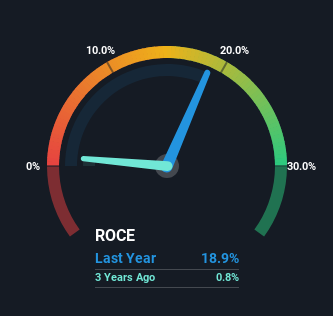- South Africa
- /
- Machinery
- /
- JSE:BEL
There's Been No Shortage Of Growth Recently For Bell Equipment's (JSE:BEL) Returns On Capital

If you're not sure where to start when looking for the next multi-bagger, there are a few key trends you should keep an eye out for. Amongst other things, we'll want to see two things; firstly, a growing return on capital employed (ROCE) and secondly, an expansion in the company's amount of capital employed. Put simply, these types of businesses are compounding machines, meaning they are continually reinvesting their earnings at ever-higher rates of return. So on that note, Bell Equipment (JSE:BEL) looks quite promising in regards to its trends of return on capital.
Return On Capital Employed (ROCE): What Is It?
For those who don't know, ROCE is a measure of a company's yearly pre-tax profit (its return), relative to the capital employed in the business. The formula for this calculation on Bell Equipment is:
Return on Capital Employed = Earnings Before Interest and Tax (EBIT) ÷ (Total Assets - Current Liabilities)
0.19 = R1.2b ÷ (R11b - R4.2b) (Based on the trailing twelve months to December 2023).
So, Bell Equipment has an ROCE of 19%. In absolute terms, that's a satisfactory return, but compared to the Machinery industry average of 8.6% it's much better.
Check out our latest analysis for Bell Equipment

While the past is not representative of the future, it can be helpful to know how a company has performed historically, which is why we have this chart above. If you're interested in investigating Bell Equipment's past further, check out this free graph covering Bell Equipment's past earnings, revenue and cash flow.
What The Trend Of ROCE Can Tell Us
Investors would be pleased with what's happening at Bell Equipment. Over the last five years, returns on capital employed have risen substantially to 19%. Basically the business is earning more per dollar of capital invested and in addition to that, 59% more capital is being employed now too. So we're very much inspired by what we're seeing at Bell Equipment thanks to its ability to profitably reinvest capital.
On a side note, Bell Equipment's current liabilities are still rather high at 40% of total assets. This effectively means that suppliers (or short-term creditors) are funding a large portion of the business, so just be aware that this can introduce some elements of risk. While it's not necessarily a bad thing, it can be beneficial if this ratio is lower.
The Bottom Line On Bell Equipment's ROCE
A company that is growing its returns on capital and can consistently reinvest in itself is a highly sought after trait, and that's what Bell Equipment has. Since the stock has returned a staggering 432% to shareholders over the last five years, it looks like investors are recognizing these changes. With that being said, we still think the promising fundamentals mean the company deserves some further due diligence.
On a separate note, we've found 1 warning sign for Bell Equipment you'll probably want to know about.
If you want to search for solid companies with great earnings, check out this free list of companies with good balance sheets and impressive returns on equity.
Valuation is complex, but we're here to simplify it.
Discover if Bell Equipment might be undervalued or overvalued with our detailed analysis, featuring fair value estimates, potential risks, dividends, insider trades, and its financial condition.
Access Free AnalysisHave feedback on this article? Concerned about the content? Get in touch with us directly. Alternatively, email editorial-team (at) simplywallst.com.
This article by Simply Wall St is general in nature. We provide commentary based on historical data and analyst forecasts only using an unbiased methodology and our articles are not intended to be financial advice. It does not constitute a recommendation to buy or sell any stock, and does not take account of your objectives, or your financial situation. We aim to bring you long-term focused analysis driven by fundamental data. Note that our analysis may not factor in the latest price-sensitive company announcements or qualitative material. Simply Wall St has no position in any stocks mentioned.
Have feedback on this article? Concerned about the content? Get in touch with us directly. Alternatively, email editorial-team@simplywallst.com
About JSE:BEL
Bell Equipment
Manufactures, distributes, and supports a range of materials handling equipment in South Africa, Europe, Rest of Africa, and internationally.
Solid track record with excellent balance sheet.

